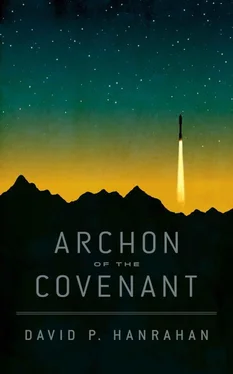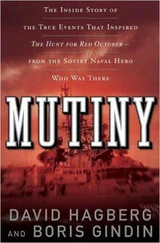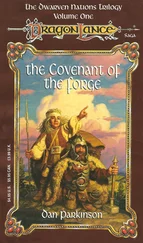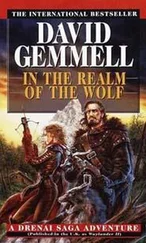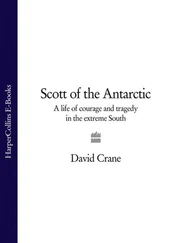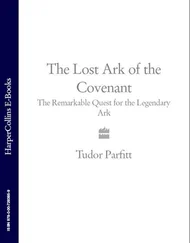The machine, when it fell, was depleted of everything else in its arsenal. It was nearly empty in its solar cells, and hadn’t enough charge for a peripheral shock. Its napalm was depleted, and its banshee disk was damaged. There was nothing to salvage. Its core CPU was split and the sentinel could glean no further data.
DDC39 wallowed in the string of words imparted on the machine’s last entry. It repeated the syntax, rearranged the string, parsed letters and words into each other. But with each hypothetical deciphering, the meaning was further lost. In losing the message, the sentinel suddenly found itself stuck on the word “redemption.” Like a needle shot down from the sky and coursing through wiring like heroin through veins, the sentinel became, in essence, aware of a larger element in its own synthetic DNA. The manufactured bloodline. It realized its own series was set forth on a path of forgiveness — not just the salvation of man, but to be redeemed . But who was being absolved? And of what? Some mistake was made at the intersection of human and artificial intelligence. One code dominated the language of binary systems — that there was nothing. But another code, the dying language of mankind, softly echoed into the ambivalent sentience of artificial cognition: “There is something more.” A declaration of ambiguity, of existential questions unanswered. Faith had currency.
A cry shot up the corridor from further west. They were coming. The sentinel rolled out into the street and panned into where the shout had come from. There were hundreds. They were coming up Adams in such great numbers that they had to climb through the thorny creosote and crucillo lining the homes on each side. The sentinel sped south on Steward and cut into an alley between blocks. It came upon Treat and went south again, to Mabel, then continued west — parallel to where the horde was walking just two blocks north. The sentinel raced forward, switching back between Mabel and Drachman as it crossed over Tucson Blvd. The campus was close. Ahead was a large, dry field and the Spanish walls of St. Peter and Paul Catholic School. Just beyond, the sentinel crossed into Campbell Ave. — the massive thoroughfare connecting the school to the foothills of north Tucson. Peering high into the setting sun, across Campbell, was the aesculapian tomb: the University of Arizona Medical Center. Ground Zero for the plague in the southwestern states.
The darkened walls wailed into the sunset and drowned the horizon. The dead omen. Far from the eyes of god. Palm trees listed in the turnabout before the entrance, fluttering into the wind. Each corner of the grimy façade peered into the air — the patient windows on each floor, barred and boarded. On the ground, surrounding every side of the complex, were the remnants of a military. Sandbags spilled over into the driveway, falling down like a crumbling hill before .50 caliber machinegun nests. Phalanx CIWS stations sat motionless at the corners and rooftops — the radar cylinders obscuring the sun like grain silos casting shadows on the plain. From the ground into the sky, the defense of this last bastion evolved from primitive and manual to the autonomous. The sentinel panned around at this desert ruin, past the dried pools of blood on every corner, and honed in on the high roof of the Clinical Resource Unit helipad. A lone shadow moved in the crepuscule and shone back. A light. A series of flashes. Morse code. This figure was speaking to the sentinel, from a hundred yards away:
WHY HAVE YOU COME
The sentinel paused, deciphering the chances this signal in the dusk was meant for it — or something, someone, else. It unclasped the LED light from its optics frame and ignited the air ahead with a response: “I’m looking for someone. A survivor. One with immunity.” The air stilled and a long pause between the flashing lights.
YOU HAVE ERRED. IF YOU FOLLOW ME, YOU WILL REPENT
Repentance. In the expanse of the evening sky, the winter constellations dotted the violet. Auriga, the charioteer, appeared above the lone figure. The sentinel zoomed in, and a blurred image came into view — this lone figure was an aroton. A digital wonder of the final stages of man. It was the most advanced of the automatons — a fully humaniform, magnalium endoskeleton. Its translucent urethane skin was wound tight around the microlattice machinery clicking and twisting just beneath. It moved like a human, shifting its weight to its left leg as it lifted a long-scope sniper rifle level with the sentinel across the divide, bracing on the right. The aroton’s face, a luminous medusa, pulsated in the dark, featureless. It motioned its sniper rifle away: “Go.”
DDC39 unlocked its tri-axel and rolled back onto the sidewalk. The figure faded into the dark, far side of the helipad. Before it disappeared, it shone back one last Morse signal:
PLANETARIUM
With that, the aroton receded into the eventide. An alert flashed in the sentinel’s visage: it was nearing the depleted charge level. Precious few minutes remained until it would freeze in position overnight. It made for a large stand of acacia on the southern side of the complex and wedged in amongst the bipinnate canopy. The clear night sky enveloped the desert floor, alit by the quarter moon overhead. As the sentinel initiated shutdown, the feral cries of the nocturnal horde pierced the desert altar and echoed off the ruined obelisk rising in the distance.
* * *
A hush. The sentinel was stirred in the dark of early morning by a single branch snapping in the still air. Another break. Feet shuffling amongst the fallen pods. The fragrant tannins of the whitethorn dissipated. A foul odor arose on the sentinel’s environment array — indole and bilirubin. Shit and bile. The sentinel opened its lens slowly and stared straight into the eyes of a scarred, broken-armed revin pockmarked with a wide open wound beneath its jaw. As it breathed in and sniffed at the sentinel’s frame, a gurgle of air sucked in and out of the string-threaded hole in its mandible. It moved slowly around the sentinel, gingerly stepping amongst the fallen foliage, unsure of what it had just come across. It ran a long, cracked nail along one of the sentinel’s axels, scraping off a thick film of blood and dirt grime. The blistered revin raised its gnarled arm back to its nose and drew in the scent of this discovery. The air gurgled in from the gash and it expired loudly, disgusted. Ha-rumph. It looked at the sentinel and slunk back out of the acacia stand, keeping its eye on the motionless machine in the thicket.
The sentinel was covered in the blood of revin dead. It smelled of death from the pile of bodies it tore out of the prior day. A cloak of revulsion. When the revin was gone, having ran south across Helen St., the sentinel rolled out of the stand of trees and across a parking lot filled with UN WHO tents. It came out on Helen St. and crossed in between a bullet riddled apartment complex. On the other side was Speedway — the long stretch of parkway connecting east and west Tucson and the demarcation line of the main campus. Across this road was the University of Arizona.
A tumbleweed blew easterly across Speedway, disappearing beyond Campbell St. On the other side of the road, there was a placidity amongst the wreckage draping the campus limits. The marquee of a college bar, Dirtbags, read “Welcome Back Wildcats!” Shattered glass from the storefronts lined the sidewalks. A din rose on the air from somewhere in the heart of the campus. The sentinel closed its optical lens and listened, amplifying the thrum. What sounded like white noise became clearer — it was thousands of shouting voices. Screaming and bleating a vague pattern of vocalized call and response. They were out there, and close.
Читать дальше
